 When cataracts form, the eye’s natural lens becomes cloudy, making it harder for light to pass through clearly. Initially, you may notice glare or halos when driving at night or in rainy conditions. As the lens grows denser, your vision becomes blurrier until it starts interfering with daily activities. That’s when it may be time to consider surgery. As Dr. Jacqueline Byrd explains, “Cataract surgery is elective, and patients decide when they’re ready based on how much it affects daily life.”
When cataracts form, the eye’s natural lens becomes cloudy, making it harder for light to pass through clearly. Initially, you may notice glare or halos when driving at night or in rainy conditions. As the lens grows denser, your vision becomes blurrier until it starts interfering with daily activities. That’s when it may be time to consider surgery. As Dr. Jacqueline Byrd explains, “Cataract surgery is elective, and patients decide when they’re ready based on how much it affects daily life.”Thinking “Optometrist Near Me” in Columbia? Start With a Cataract Consultation
Cataract surgery is one of the most common surgeries performed in the United States, and it’s highly effective. Dr. Byrd notes, “People don’t have to live with decreased vision due to cataracts as they age. Once we remove the cataract, vision is restored to how it was before.” At Missouri Eye Consultants, your journey begins with a comprehensive exam, dilation, precise measurements, and a clear discussion of lens options, their benefits, and any out-of-pocket costs.
What Is a Light Adjustable Lens (LAL)?
During cataract surgery, the cloudy natural lens is replaced with an intraocular lens (IOL). Traditional IOLs are fixed prescription lenses chosen based on pre-surgery measurements, such as eye length and corneal curvature. While these measurements are highly accurate, they’re not always perfect—especially if you’ve had LASIK or RK.
A Light Adjustable Lens (LAL) is different. Its power can be fine-tuned after surgery using controlled UV light treatments in the clinic. This allows your surgeon to adjust clarity for distance or near vision. Think of it as an insurance policy for your eyesight.
Why Do “Refractive Surprises” Happen — and How LAL Helps
A “refractive surprise” occurs when post-surgery focus doesn’t match the predicted outcome. With fixed IOLs, what you get after surgery is final. LAL technology minimizes this risk by allowing your doctor to adjust the implant’s prescription after healing—and tweak it again if needed—until your vision aligns with your goals.
Who Is a Good Candidate?
Most patients are excellent candidates for LAL. It is particularly beneficial if you’ve had LASIK or RK, since those procedures can make measurements less predictable. It’s also an excellent option for patients aiming to reduce their dependence on glasses. Dr. Byrd explains that patients can “try out” sharper distance or near vision, then adjust again based on real-world experience.
Choosing the Right Eye Doctor in Columbia for Cataract Surgery
With LAL, the conversation is as important as the technology. Your surgeon and optometrist will discuss your lifestyle—work demands, hobbies, and reading habits—to help decide whether distance, near, or monovision is best for you. Many patients begin with a gentle monovision adjustment, test their vision for a week, then decide if they prefer sharper distance or stronger near vision.
What to Expect With LAL at Missouri Eye Consultants
Healing takes about a month before adjustments can begin. During this time, you’ll wear special UV-blocking glasses to prevent accidental changes to the lens. Adjustments are performed in-office using a chin rest and a brief UV light treatment lasting 30 seconds to two minutes per eye.
Vision typically begins to change within 24 to 48 hours. Most patients need up to three adjustment visits per eye, followed by two lock-in sessions to finalize the prescription. After the lock-in, you can stop wearing the protective glasses.
Recovery and Comfort
Whether you choose a fixed IOL or LAL, cataract surgery is outpatient and generally painless. Most patients notice brighter vision the next day, though some blurriness is normal during healing. With a fixed IOL, you’ll likely update your glasses prescription after the first month. With LAL, that month is used for healing before adjustments begin—so your vision can be fine-tuned until it’s just right.
Real-World Results Patients Love
Dr. Byrd shares that many LAL patients achieve exceptionally sharp distance vision, often 20/15, along with excellent near outcomes. Patient feedback is overwhelmingly positive, with many calling it the best investment they’ve ever made—and wishing they had done it sooner.
Ready to Personalize Your Vision?
If you’re searching for an optometrist near you in Columbia, schedule a consultation with Missouri Eye Consultants to learn more about Light Adjustable Lenses. Our team provides advanced diagnostics, thoughtful counseling, and a clear treatment plan—from surgery through lock-in—to help you achieve vision tailored to your lifestyle.
FAQS
What are cataracts, and how do they affect vision?
Cataracts are a clouding of the eye’s natural lens. Early signs include glare and difficulty driving at night. As cataracts progress, vision becomes blurrier until daily activities are affected.
When is the right time for surgery?
Cataract surgery is elective. Most patients choose surgery when their vision begins to limit their safety or quality of life, such as difficulty driving in low-light conditions.
How is LAL different from standard IOLs?
Standard IOLs are fixed, while LAL can be adjusted after surgery using UV light. This reduces the chance of a refractive surprise and allows for more personalized results.
Am I a candidate if I’ve had LASIK?
Yes. LAL is an excellent option for patients who have had LASIK or RK because it improves predictability.
How many visits are needed for LAL?
Plan for at least three light treatments—one or more adjustments, then two lock-ins—usually spaced about a week apart.
Do I need special glasses after surgery?
Yes. You’ll wear UV-blocking glasses from the time of surgery until your final lock-in to protect the lens from unintended changes.
